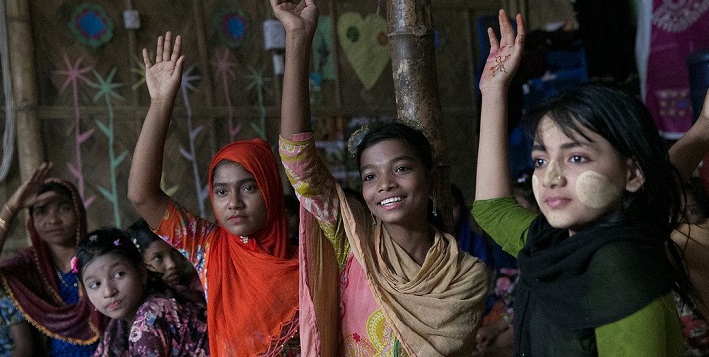By Sucharita Sengupta
Eking out a living is a huge challenge for hundreds of thousands of women living in the bleak camps in Cox’s Bazar.
Thin, under-nourished women, clad in cotton saris and headscarves, sit on their haunches amid the warren of mud and thatched huts.
They speak among themselves in a strange patois – part Bengali, part Arakanese – staring up every now and then to make eye contact with the aid workers milling about the Rohingya refugee camps.
Thirty-seven-year-old Shagufta Ismail (name changed to protect identity) lives in one of the cramped huts of Camp 14 – the ‘widow block’.
She came here along with two children in 2017 following the ethno-religious violence in the Rakhine State that forced hundreds of thousands of Muslim Rohingya refugees to cross the Myanmar-Bangladesh border and seek refuge in Cox’s Bazar.
Most humanitarian crises affect women and children badly but the Rohingya catastrophe is worse, especially for women. Even as Rohingya women refugees have little or no access to stable economic opportunities, especially in the face of widespread poverty, many have taken to prostitution as a means of survival.
The security situation in the camps has also deteriorated with reports of crimes against women, including sexual assault.
Also Read: Why the Rohingya are being treated the way they are
Shagufta’s condition is representative of Rohingya refugee women’s insecurities and vulnerabilities that stem from displacement and the consequent lack of belonging in a foreign land. Their experience is different from the Rohingya men.
Two years after the Rohingya exodus, only 20 widows lived in the constricted huts of the refugee camps.
Also Read: How can a state make people stateless?
While their numbers grew over the years, their general condition did not improve – an existence marked by uncertainty, lack of sanitation and a general degradation.
However, amid the reports of wretchedness in the Cox’s Bazar camps – there are now an estimated 1 million refugees – there are flickers of hope.
Also Read: Rohingya conundrum: Stateless, helpless and unwanted
Seventeen-year-old Parveen Iqbal (name changed), for instance, wants to be “as free as you are, study and get a job”.
Parveen, along with her family, fled the Rakhine State in August 2017 when she was in middle school. Her dreams remained unrealised but her conviction, that education was the surest means to a good life and eventually freedom, was shared by many others.
Meanwhile, left to fend for herself, Shagufta, like the other “widows”, managed their households alone in conditions of extreme privation and continued violence. They selected their representatives, responsible for each camp block, from among themselves, indicating coordination and leadership in the camps.
The representatives often act as mediators between the refugees and camps-in-charge. This was in stark contrast to before 2017 when they could rarely voice their opinions or exercise choices within their own homes.
Violent conflicts have a greater impact on women since they become the target of gender-specific human rights violations. Women are doubly marginalised and oppressed due to political beliefs, ethnicity, religion and nationality.
All of this and more has been happening at Cox’s Bazar’s 34 Rohingya camps.
A 2024 Humanitarian Needs and Response Plan report says that women and children have been the worst affected, with many suffering from malnutrition.
They are in dire need of healthcare, education, food security, protection and phycological care. While financial distress and economic crisis among the Rohingya have deepened, many lost their jobs with humanitarian organisations and NGOs during the pandemic.
The Rohingya women refugees form a diverse group in terms of their background, choices, access to resources and networks both in Myanmar and Bangladesh.
For instance, Parveen’s hut had two rooms with several electronic gadgets and a small separate space as the kitchen.
Many of the women also had access to solar power which can be rented for a cost. Parveen’s father can afford to pay rent, but most families cannot.
The ‘widow block’ residents had less money or spending power. Land was allocated to them based on what their purse allowed. Land was costlier in areas with better access to latrines, drinking water, tube wells and other amenities.
For women such as Parveen, the camps provide job opportunities through involvement with NGOs.
Such camps are not as liveable as the ones in Myanmar where Parveen’s family enjoyed better access to social and cultural institutions.
Most other women had little or no access to basics, including full rations, a stove, cooking gas, water, sanitation or even proper shelter.
The humanitarian response platform, a collective of INGOs and local NGOs, formed to render aid to the Rohingya in Bangladesh, is focused on ensuring gender rights and preventing sexual violence against women and children.
Although there is no system of imparting formal education in the camps, the United Nations Entity for Gender Equality and the Empowerment of Women (also known as UN Women), has been collaborating with local NGOs to initiate and run education awareness programmes.
Some of these NGOs operate separate ‘safe centres’ that impart skill training and create space for women and girls to share personal problems.
A few groups formed in the camps work to promote leadership and equal representation for women, especially on critical issues such as protection.
Rohingya women volunteer in active initiatives as assistants in health facilities and as assistants to midwives and doctors, as hygiene promoters to build awareness on safe drinking water and to teach how to use tube wells and washrooms/latrines, and as emergency responders, to provide basic first aid and lead search and rescue missions.
Many women and girls such as Parveen and Anwara Khatun (name changed) are evolving as a consequence of access to education and employment.
Notwithstanding such success stories, severe constrictions impede the development of many others.
Turning skills into commercial purposes, even when they want to, has not happened. Rashida Bano (age 24) of Camp 9 at Balukhali, said, “I know sewing and have a machine donated by a local NGO, but I mostly stitch our own clothes”.
She sought help “several times” from a few NGO workers “but such assistance did not materialise”. Her decision to send her daughter to skills sessions did not yield the desired results. Workshops organised from time to time were of little help.
Amid such dire economic conditions, there are reports of child marriage and early pregnancy resulting in enlarged families with the children unable to get basic education.
Rohingya women’s sufferings are compounded by low levels of literacy that restrict many of them from securing jobs. Their plight becomes extreme when they are unable to access latrines built far from their humble dwellings.
While rising forced prostitution within and outside the camps is a matter of concern, it is also time to consider these options as labour of choice for women.
At times, the line between force and volition obliterates, and is triggered by reasons of economic want. This autonomy must be recognised even within the ambit of coercive external forces.
Rohingya women such as Parveen survive in the zone of hope and eventual change – for justice. They believe that justice in the form of a legal redressal in their homeland, Myanmar, will provide them the security necessary for facilitating their return in the future.
Sucharita Sengupta is a researcher at the Calcutta Research Group. Before taking a PhD from the Graduate Institute of International and Development Studies, Geneva, in July 2023, she was a teaching assistant there between 2019 and 2021. She has worked extensively on issues related to migration and forced migration in South Asia.
The research was undertaken with financial assistance (scholarship and field visit sponsorship) from the Geneva Graduate Institute, Switzerland.
This article is part of a Special Report on the Rohingya refugees produced in collaboration with the Calcutta Research Group and the Asian Broadcasting Union.
Originally published under Creative Commons by 360info™.















